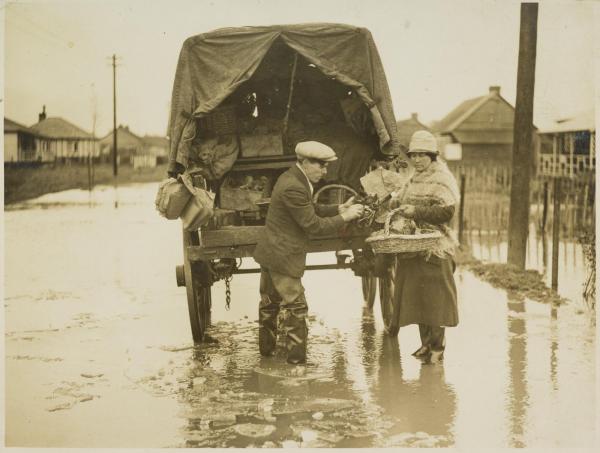The MacKinnon Collection is a treasure trove of historic photographs illustrating over 100 years of life in Scotland. It was acquired jointly by the National Galleries of Scotland and National Library of Scotland in 2018 with assistance from the National Lottery Heritage Fund, Scottish Government and Art Fund.
Since its arrival the collection has been the subject of a major project including cataloguing, research, digitisation and exhibitions, with a touring programme in progress. For the conservation teams at the Galleries and the Library, the project has entailed assessing the condition of the collection and deciding how best to care for it, to ensure its preservation for many years to come.

The collection consists of around 15,000 photographs: many are loose or framed individually, and others are displayed inside over 100 photograph albums and 30 books.
A wide range of historic photographic printing processes and materials are represented, including daguerreotypes, salted paper prints, albumen prints, collodion prints, gelatine prints, photomechanical prints, ambrotypes, autochrome plates, lantern slides, glass and plastic negatives.
When the collection was examined in 2017 prior to being acquired, its condition was assessed by selectively examining a number of objects, and since its arrival more thorough condition assessments have taken place. These have confirmed that the collection is generally very well preserved.

It is important that photographic collections are kept in high quality storage enclosures. This protects the photographs from dust, gaseous pollutants and sudden changes in temperature and relative humidity, and reduces the risk of physical damage such as scratches, cracks and tears.
The majority of the single prints are housed in high quality polyester sleeves and envelopes, stored inside solander boxes, and the small cased photographs, daguerreotypes and ambrotypes are housed in special made folders, again inside solander boxes.
However, the glass plate and acetate negatives, autochromes and lantern slides currently reside within various types of non-archival boxes, some dating from when the photographs were first made. These have historical interest but may have drawbacks from a conservation perspective, for example if they are made from acidic cardboard. This non-archival storage is therefore being reviewed and will soon be upgraded, although all of the historic boxes and envelopes will also be kept.
The storage environment is also a key consideration. Photographic collections generally prefer low temperatures with relatively low relative humidity, which inhibits deterioration such as fading, discoloration and silver mirroring. The conditions in the storage spaces at the Galleries and the Library are therefore carefully monitored and controlled. Some photographs are also very sensitive to light, so the stores must be kept in complete darkness when the photographs are not being used.
Even with optimum storage, some items have suffered damage or deterioration in the past which we need to address. Deterioration is often accelerated by poor storage conditions, but historic photographs may also have inherent instabilities arising from the materials and techniques used to make them, particularly when early photographers were being experimental. Minor issues found in the Mackinnon collection include staining and brown spotting (foxing) of the paper and boards used to support and mount the photographs, small losses to photograph frames and some silver mirroring and discoloration of glass plate negatives, autochromes and lantern slides. We are gradually addressing these issues with minor conservation treatments such as surface cleaning, tear repairs and consolidations.
Additionally some of the daguerreotypes are suffering from a type of deterioration known as ‘glass disease’, caused by soluble salts moving to the surface of the glass and crystallizing, resulting in small droplets forming on the glass and pitting of the glass. These items are clearly priorities for conservation treatment, which entails opening, cleaning and resealing the daguerreotype cases.
During the condition assessment, particular attention was paid to the plastic negatives. Prior to the introduction of polyester films, most plastic negatives were either made from cellulose nitrate or cellulose acetate. Cellulose nitrate is problematic because it releases nitric oxide and nitrogen dioxide as it deteriorates and is highly flammable. Cellulose acetate is not flammable, although it may also off-gas as it deteriorates, releasing acetic acid with a distinctive smell which causes the phenomenon to be described as ‘vinegar syndrome’. Cellulose nitrate can usually be identified through a combination of the date of manufacture, the appearance of the film - for example many manufacturers printed ‘nitrate’ or ‘safety’ along one border of the film – and the evidence of deterioration. Our assessment to date has suggested that there is no cellulose nitrate in the collection, and that the cellulose acetate negatives are in good condition, with no discernible onset of vinegar syndrome.
Given the scale of the MacKinnon Collection, there is clearly plenty to keep the conservation teams at the Galleries and the Library busy, and as we focus in on particular parts of the collection we are making new discoveries and finding new challenges. We will explore some of these issues in future blogs.
The MacKinnon Collection was acquired jointly with the National Library of Scotland with assistance from National Lottery Heritage Fund, Scottish Government and the Art Fund.



